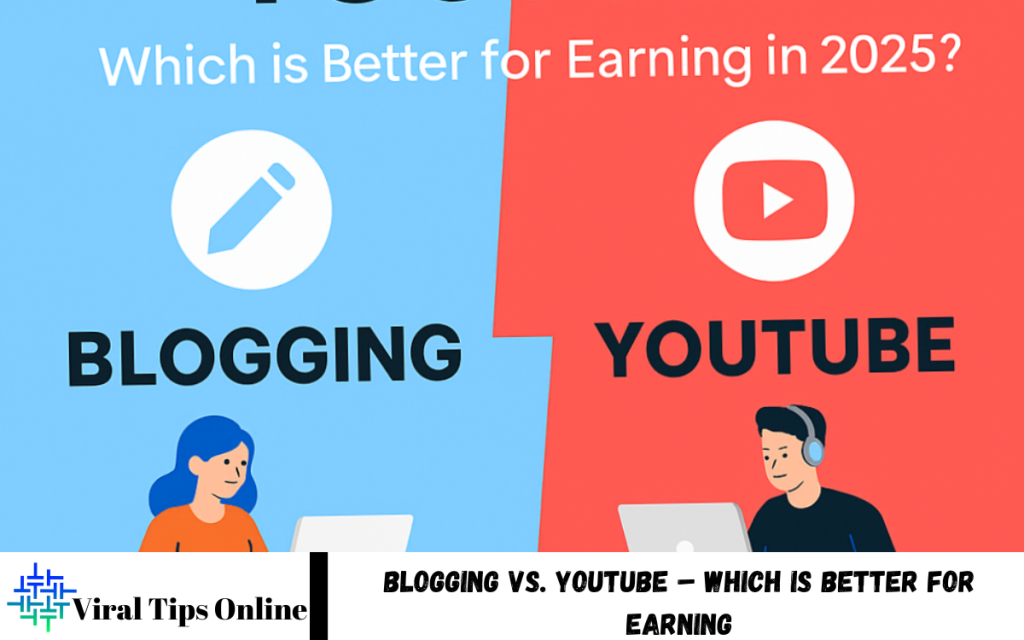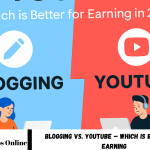Blogging and YouTube are two of the most popular ways to earn money online. Both platforms allow creators to share their knowledge, creativity, and opinions with a global audience but each comes with its own advantages and challenges. Blogging relies on written content, SEO, and website traffic to generate income through ads, affiliate marketing, and sponsored posts.
On the other hand, YouTube focuses on video content, offering faster audience engagement and the potential to go viral. Creators can earn through ad revenue, brand partnerships, memberships, and product promotions. It often requires more investment in equipment, editing, and on-screen presence.
Understanding Blogging
Blogging is the process of creating and publishing written content on a website. It involves writing articles, guides, tutorials, or news posts around specific topics or niches. Bloggers attract readers using search engine optimization (SEO) and earn money through various channels such as Google AdSense, affiliate marketing, sponsored posts, and digital product sales.
A blogger owns their content and has full control over their website. It allows long-term income growth since blog posts continue generating traffic and revenue for years after publishing.
Understanding YouTube
YouTube is a video-sharing platform where creators publish videos to engage viewers. The YouTube Partner Program enables creators to earn money from ads displayed on their videos. YouTubers also generate income through brand sponsorships, affiliate links, memberships, live streams, and merchandise sales.
Unlike blogging, YouTube demands strong visual presentation skills, consistency in uploading videos, and a basic understanding of video editing. However, YouTube offers faster audience growth and higher engagement rates compared to blogs.
Investment and Setup
Blogging Setup:
- Requires a domain name and web hosting.
- WordPress or Blogger can be used to start.
- Basic investment: around $50–$100 for domain and hosting.
- Tools: keyword research tools, SEO plugins, and analytics.
YouTube Setup:
- Requires a smartphone or camera, microphone, and basic lighting.
- No domain or hosting cost, but video equipment can cost $100–$500.
- Free to start a channel, but professional editing tools may add expenses.
Verdict: Blogging is cheaper to start, while YouTube needs more initial equipment investment.
Content Creation Effort
Blogging:
- Involves keyword research, writing, editing, formatting, and publishing.
- SEO plays a vital role in ranking on search engines.
- Content can be repurposed into guides or eBooks.
YouTube:
- Involves scripting, filming, voiceovers, editing, and thumbnail creation.
- Requires creativity, good camera presence, and storytelling.
- Visual content performs better but demands more time and effort.
Verdict: YouTube requires higher creative effort, while blogging focuses more on research and writing.
Monetization Opportunities
Blogging Monetization Methods:
- Google AdSense: Earn through ads displayed on your blog.
- Affiliate Marketing: Promote products and earn commissions.
- Sponsored Posts: Collaborate with brands for paid promotions.
- Selling Digital Products: Offer courses, eBooks, or templates.
- Membership Sites: Offer premium content for paid subscribers.
YouTube Monetization Methods:
- YouTube Partner Program: Earn ad revenue from videos.
- Sponsorships: Partner with brands for paid promotions.
- Affiliate Links: Add links in video descriptions.
- Channel Memberships: Offer exclusive perks for paying members.
- Merchandise Shelf: Sell branded products directly.
Verdict: Both have multiple income sources. However, YouTube may offer faster visibility, while blogging provides stable passive income.
Audience Growth and Reach
Blogging:
- Growth depends on SEO ranking and organic traffic.
- It can take 6–12 months to gain consistent readers.
- Blogs rely heavily on search engines and backlinks.
YouTube:
- Easier to go viral with quality content.
- Algorithm recommends videos to new audiences quickly.
- Engagement through comments, likes, and shares boosts visibility.
Verdict: YouTube allows faster audience growth, while blogs grow slower but sustain longer.
Passive Income Potential
Blogging:
Once ranked, blog posts generate continuous traffic and income even when you are not actively posting. Evergreen content like “how-to guides” or “reviews” can bring consistent earnings for years.
YouTube:
Videos continue earning views and ad revenue over time, but performance depends on algorithm updates and audience engagement.
Verdict: Blogging has more stable passive income potential, while YouTube income fluctuates with trends and watch time.
Read Also: 10 Blogging Mistakes That Are Killing Your Traffic
Skill Requirements
For Blogging:
- Writing and storytelling.
- SEO and keyword optimization.
- Website management and analytics.
- Content marketing and link building.
For YouTube:
- Video production and editing.
- Presentation and communication skills.
- Thumbnail and title optimization.
- Audience engagement strategies.
Verdict: Blogging suits those who enjoy writing; YouTube fits those confident in front of a camera.
Time to Earn
Blogging:
- Takes 6–12 months to earn consistent income.
- Requires patience and consistent posting.
- Traffic and income grow gradually.
YouTube:
- May take 3–6 months to qualify for monetization.
- Viral videos can speed up earnings.
- Income depends on views and watch hours.
Verdict: YouTube can generate income faster, but blogging ensures long-term growth.
Algorithm and Platform Control
Blogging:
- You own your website and control all content.
- Less risk of account suspension.
- SEO algorithm changes affect ranking but not ownership.
YouTube:
- Platform rules can impact earnings.
- Videos can be demonetized or removed.
- Channel suspension risk exists for policy violations.
Verdict: Blogging offers full control, while YouTube depends on platform policies.
Income Comparison
Blogging Average Earnings:
- Beginner: $100–$500 per month.
- Intermediate: $1,000–$5,000 per month.
- Professional: $10,000+ monthly through multiple income streams.
YouTube Average Earnings:
- Beginner: $50–$300 per month.
- Intermediate: $1,000–$5,000 per month.
- Top YouTubers: $10,000–$100,000+ monthly through ads, sponsorships, and brand deals.
Verdict: YouTube can bring higher short-term income, while blogging provides consistent, long-term profits.
Pros and Cons Summary
| Aspect | Blogging | YouTube |
|---|---|---|
| Startup Cost | Low | Moderate to High |
| Effort Type | Writing & SEO | Filming & Editing |
| Growth Speed | Slow & Steady | Fast with Viral Content |
| Earning Stability | Long-Term Passive | Depends on Engagement |
| Skill Need | Writing & Research | Video Presentation |
| Platform Control | Full Ownership | Platform-Dependent |
| Audience Type | Readers | Visual Learners |
Which is Better for Earning?
Choosing between blogging and YouTube depends on your skills and long-term goals.
- If you enjoy writing, SEO, and long-term stability, blogging suits you better.
- If you prefer visual content, quicker audience growth, and creative expression, YouTube is more profitable.
Many creators today use both — running a blog to rank on Google and a YouTube channel to attract visual audiences. Combining both platforms multiplies visibility and income potential.
Future of Blogging and YouTube in 2025
Both blogging and YouTube continue evolving. AI-assisted content creation, voice search, and short-form video trends are reshaping the digital landscape. Blogs focusing on helpful, authentic content rank better, while YouTubers creating engaging and informative videos see rapid growth.
In 2025 and beyond, creators who combine both written and visual storytelling will have the strongest online presence and earning opportunities.
Frequently Asked Questions
Which is easier to start Blogging or YouTube?
Blogging is easier and cheaper to start since it requires only a domain and hosting. YouTube needs camera equipment, video editing tools, and more creative skills, but it can grow faster once you start.
Can I do both Blogging and YouTube together?
Yes. Many creators use both platforms to maximize reach and income. You can use your blog to publish written content and YouTube to promote videos, creating a strong digital brand.
Which platform is better for passive income?
Blogging is better for passive income. Once a blog post ranks on Google, it can generate continuous traffic and earnings for years without active updates.
What skills are required for blogging?
Bloggers need writing skills, SEO knowledge, keyword research, and basic website management. Creativity and consistency are key to building loyal readers.
What skills are required for YouTube?
YouTubers need video production, editing, presentation, and storytelling skills. Understanding YouTube SEO and analytics helps in audience growth and monetization.
Which platform gives faster results?
YouTube usually gives faster results because videos can go viral quickly. Blogs take time to rank in search engines but provide more stable long-term traffic.
Which is better for beginners in 2025?
If you enjoy writing and prefer working behind the scenes, start blogging. If you love presenting and connecting through video, choose YouTube. Both can become full-time income sources when managed properly.
Conclusion
The debate between Blogging vs. YouTube – Which is Better for Earning has no single answer. Both platforms can turn into full-time income sources when approached strategically. Blogging offers stability and ownership, while YouTube delivers faster visibility and engagement. Success depends on consistent effort, quality content, and smart monetization strategies. Whether you choose blogging, YouTube, or both focus on creating valuable content that educates, entertains, and connects with your audience. That’s the real key to sustainable online earning.






